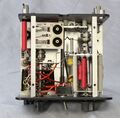1230-A: Difference between revisions
Jump to navigation
Jump to search
No edit summary |
No edit summary |
||
| Line 12: | Line 12: | ||
* [[Media:GRwiki 1230A Electometer 1230-0100-F 02_1962.pdf|General Radio 1230-A Electrometer and DC Amplifier Manual 1230-0100F 1962]] | * [[Media:GRwiki 1230A Electometer 1230-0100-F 02_1962.pdf|General Radio 1230-A Electrometer and DC Amplifier Manual 1230-0100F 1962]] | ||
}} | }} | ||
The '''General Radio 1230-A Electrometer and DC Amplifier''' was introduced in | The '''General Radio 1230-A Electrometer and DC Amplifier''' was introduced in {{Catalog O}} and remained available through {{Catalog T}}. | ||
The Type 1230-A is laboratory instrument designed for the measurement of extremely small voltages or currents and conversely extremely large resistances. It achieves this with the 5886 electronmeter vacuum tube used in the first stage of amplification. The combined gain of the three stages result is a transconductance in the millions of micromhos. The output of the amplifier is read from the panel meter or an optional recorder connection at the rear panel. The recorder terminals are in series with the meter so a resistor is required without a recorder connected. | The Type 1230-A is laboratory instrument designed for the measurement of extremely small voltages or currents and conversely extremely large resistances. It achieves this with the 5886 electronmeter vacuum tube used in the first stage of amplification. The combined gain of the three stages result is a transconductance in the millions of micromhos. The output of the amplifier is read from the panel meter or an optional recorder connection at the rear panel. The recorder terminals are in series with the meter so a resistor is required without a recorder connected. | ||
Revision as of 04:26, 2 April 2024
The General Radio 1230-A Electrometer and DC Amplifier was introduced in Catalog O (1956) and remained available through Catalog T (1968).
The Type 1230-A is laboratory instrument designed for the measurement of extremely small voltages or currents and conversely extremely large resistances. It achieves this with the 5886 electronmeter vacuum tube used in the first stage of amplification. The combined gain of the three stages result is a transconductance in the millions of micromhos. The output of the amplifier is read from the panel meter or an optional recorder connection at the rear panel. The recorder terminals are in series with the meter so a resistor is required without a recorder connected.
Specifications
- RANGES OF MEASUREMENT
- Voltage: ±30, 100, and 300 mV; ±1, 3, and 10 V; DC full scale
- Current: ±1 mA DC, full scale, to ±0.3 pA full scale; Measured in terms of voltage
- Resistance: direct reading from 300 kΩ to 10 TΩ full scale; There are 16 ranges, two per decade. Voltage across the unknown resistance is 9.1 V
- ACCURACY
- Voltage: ±2% of full scale on the five highest ranges, ±4% of full scale on the 30 mV range
- Current: ±3% of full scale from 1 mA to 1 nA, ±10% of full scale from 300 pA to 0.3 pA
- Resistance: ±3% from 300 kΩ to 10 MΩ at full scale (low-resistance end), ±8% from 3 MΩ to 10 TΩ







